DAMAGE TO FUKUSHIMA REACTORS WORSE THAN PREVIOUSLY THOUGHT
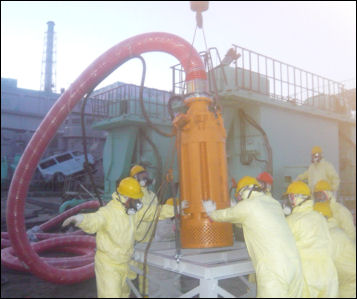
work on submerslble cable In April 2011, Tokyo Electric Power Co. (TEPCO), the operator of the crippled Fukushima plant, has said the cores of the Nos. 1 to 3 reactors have been damaged by 25 percent to 70 percent. But the agency at that stage emphasized that the figures were only estimates. “The disaster damaged some reactors' pressure and containment vessels, causing leaks of radioactive water that were detected in turbine building basements and maintenance tunnels outside the area restricted due to radiation. The contaminated water posed a major hindrance to efforts to restore electricity to the reactors.:[Source: Yomiuri Shimbun, April 2011]
The Yomiuri Shimbun reported: “The pressure vessel of the No. 1 reactor at the Fukushima No. 1 nuclear power plant is believed to have been damaged five hours after the March 11 earthquake, according to an analysis by the Nuclear and Industrial Safety Agency. The finding differs with a provisional analysis earlier released by plant operator Tokyo Electric Power Co., which stated the the pressure vessel was believed to have been damaged 15 hours after the March 11 Great East Japan Earthquake. [Source: Yomiuri Shimbun, June 8, 2011]
“NISA, a nuclear watchdog body run by the Economy, Trade and Industry Ministry, disclosed the results of a detailed analysis regarding damage at the Nos. 1 to 3 nuclear reactors at the Fukushima facility. NISA estimates that the No. 2 reactor's pressure vessel was damaged 80 hours after the disaster. TEPCO's analysis contends the No. 2 reactor's pressure vessel was damaged 109 hours after the quake.”
According to NISA's analysis, the No.1 reactor's core began suffering damage three hours after the earthquake. The No. 1 reactor's pressure vessel was damaged at 8 p.m. on March 11, five hours after the earthquake. The No. 2 reactor's pressure vessel suffered damage at 10:50 p.m. on March 14, while the No. 3 reactor's pressure vessel suffered damage at 10:10 p.m. on March 14. NISA data showed the pressure vessels at the Nos. 1 and 2 reactors were damaged earlier than TEPCO's analysis showed.
On the other hand, the No. 3 reactor's pressure vessel was found to have been damaged 13 hours later than TEPCO's data showed. NISA presumed the vessels failed when there was almost no water in the reactor cores of the Nos. 2 and 3 reactors.
Links to Articles in this Website About the 2011 Tsunami and Earthquake factsanddetails.com : MARCH 2011 EARTHQUAKE AND TSUNAMI IN JAPAN: DEATH TOLL AND ITS BEGINNING factsanddetails.com ; ARTICLES ABOUT THE CRISIS AT THE FUKUSHIMA NUCLEAR POWER PLANT Factsanddetails.com/Japan ; DAMAGE FROM 2011 EARTHQUAKE AND TSUNAMI Factsanddetails.com/Japan ; EYEWITNESS ACCOUNTS AND SURVIVOR STORIES Factsanddetails.com/Japan ; FUKUSHIMA NUCLEAR POWER PLANT DISASTER AFTER THE MARCH 2011 EARTHQUAKE AND TSUNAMI factsanddetails.com ; MELTDOWNS AT THE FUKUSHIMA NUCLEAR POWER PLANTS factsanddetails.com ; EARLY HOURS OF THE FUKUSHIMA NUCLEAR DISASTER factsanddetails.com ; TEPCO AND THE FUKUSHIMA NUCLEAR POWER PLANT DISASTER: SHODDY SAFETY MEASURES, THE YAKUZA AND POOR MANAGEMENT factsanddetails.com ; JAPANESE GOVERNMENT'S HANDLING OF THE TSUNAMI AND THE FUKUSHIMA NUCLEAR DISASTER factsanddetails.com ; BRAVE WORKERS AND ROBOTS AT THE FUKUSHIMA NUCLEAR POWER PLANT factsanddetails.com ; RADIOACTIVE WATER CONTAINMENT AT FUKUSHIMA NUCLEAR POWER PLANT factsanddetails.com COLD SHUTDOWN AND LONGER TERM MANAGEMENT OF FUKUSHIMA NUCLEAR CRISIS factsanddetails.com ; RADIATION RELEASES, FEARS AND HEALTH CONSEQUENCES OF THE FUKUSHIMA NUCLEAR DISASTER factsanddetails.com
Damage to Containment Vessels at the Fukushima Reactors
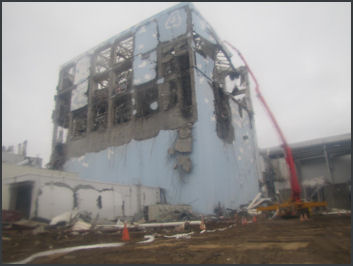
water pumping In May 2011, TEPCO said that not only the pressure vessels, but the containment vessels of the Nos. 1 to 3 reactors at the Fukushima No. 1 nuclear power plant were probably damaged within 24 hours of the March 11 earthquake and tsunami. The finding, released as a report to Japanese government nuclear agency, was based on the analysis and minute calculations on internal pressure and other measurements in the nuclear reactors after the earthquake. [Source: Yomiuri Shimbun, May 26, 2011]
According to the Yomiuri Shimbun: TEPCO said it found that an isolation condenser, a type of emergency cooling device, did not work properly at the No. 1 reactor. This caused the core meltdown to progress until it damaged the bottom of the pressure vessel about 15 hours after the earthquake. Along with the meltdown, the temperature inside the steel containment vessel, which contains the pressure vessel, rose until it reached 300 C in 18 hours after the quake, much higher than 138 C the vessel was designed for. It is believed the internal temperature continued to rise after that.
Containment vessels are designed for a much lower temperature and pressure than pressure vessels, which can be exposed to temperatures close to 300 C and pressure reaching 70 bars when a reactor is in operation. Rubber and metal parts used to seal pipes and other devices in the containment vessel apparently deteriorated quickly under temperatures exceeding 300 C. This may have caused steam containing radioactive materials to leak, the report said.
The pressure inside the containment vessel reached 8.4 bars 12 hours after the quake, which is nearly two times the pressure it was designed for. Damage to the containment vessel might have progressed faster than the analysis, TEPCO said. On the basis of fluctuations in pressure measurements inside the containment vessel of the No. 2 reactor, it is assumed a 10-centimeter-diameter hole appeared in the side of the vessel, causing steam to leak 21 hours after the quake. If there was no leakage, the rise of internal pressure would have been much sharper. This makes it difficult to explain the actual pressure measurements. Damage in a pressure control chamber has already been acknowledged, but damage to the containment vessel itself has not been confirmed.
Pumping Seawater on the Reactors
Workers used the process of “feed and bleed” — feeding cool water around the reactors’ fuel rods to bleed away excess heat. “Pumping water into nuclear reactors and storage pools for spent fuel rods at the Fukushima No. 1 power plant was an indispensable move. If the reactors were not kept cool and the pools full, an even worse disaster could have occurred at the stricken nuclear facility.”
According to data released by TEPCO on May 16, injection of seawater into the No. 1 reactor began at 7:04 p.m. on March 12. TEPCO decided to use seawater because its freshwater supply was running short. According to the sources, TEPCO informed Kan in advance about the plan to switch from freshwater to seawater. Kan asked Haruki Madarame, chairman of the Cabinet Office's Nuclear Safety Commission whether injecting seawater would pose a risk of re-criticality, and Madarame said it was possible. Therefore at 6 p.m. March 12, Kan instructed the commission and the Nuclear and Industrial Safety Agency of the Economy, Trade and Industry Ministry to examine the possibility that injecting seawater would lead to re-criticality. Later Madarame said he said no such thing, adding “I’m insulted by the claim.” [Source: Yomiuri Shimbun, May 22, 2011]
Because the prime minister expressed concern, TEPCO stopped injecting seawater at 7:25 p.m., about 20 minutes after it had begun. At 7:40 p.m., the commission reported to Kan that injecting seawater would not trigger re-criticality. At 7:55 p.m., Kan ordered Economy, Trade and Industry Minister Banri Kaieda to instruct TEPCO to resume injecting seawater. TEPCO did so at 8:20 p.m. It was originally that injection of seawater was stopped for about 55 minutes but it turned out that plant chief Masao Yoshida disobeyed the order and kept injecting seawater even though he was todl not to. Kan denied claims that he instructed TEPCO to stop injecting seawater into the No. 1 reactor.
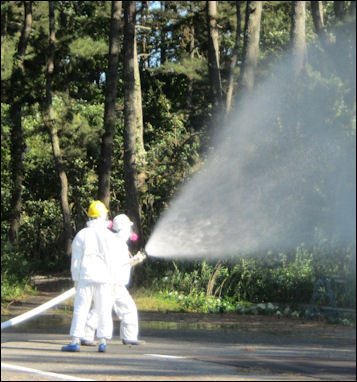
spraying purified water Prof. Hisashi Ninokata of Tokyo Institute of Technology, an expert in nuclear reactor engineering, said: "It's certain the nuclear fuel rods inside the No. 1 reactor were damaged. It's highly likely that suspending the injection of seawater made the situation worse." "As it was the second day of the crisis, there was almost no information about conditions inside the reactor, and thus it was necessary to cool the fuel at any cost," Ninokata said. "Even if the seawater caused re-criticality, it wouldn't discharge extremely high levels of energy. If the prime minister was more afraid of re-criticality [than of the nuclear fuel continuing to overheat], he was completely wrong."
Between March 12 — the day after the plant was damaged by a massive earthquake and tsunami — and April 12 about 30,000 tons of water have been sprayed into the reactors by Self-Defense Forces, police and other workers.” [Source: Yomiuri Shimbun, April 2011]
But the action was not without consequences. Water inside the building of the second reactor became so contaminated that a worker would only be able to be exposed to it for no more than fifteen minutes each year. Ironically, the water that was so essential to cool the reactors turned out to be the biggest obstacle to repairing them, a development no one in the government anticipated. TEPCO officials thought they could end the water pouring operations if the cooling system could be repaired. The most important thing, they felt, was cooling the reactor cores. Pouring water on the reactors was therefore only a stopgap measure and they never considered what would happen if the water used became highly radioactive and leaked to other parts of the plant.” [Source: Yomiuri Shimbun, April 2011]
Pools of contaminated water have been found in the Nos. 1, 2 and 4 reactors. The most problematic was water in the No. 2 reactor building that measured more than 1,000 millisieverts per hour. "I can barely stand to look at that figure," Hidehiko Nishiyama, spokesman of the Nuclear and Industrial Safety Agency, said at a news conference.
When TEPCO official Teruaki Kobayashi was asked what would happen to the water being sprayed by fire engines and helicopters he said it would "stay in the reactor building because it's designed to prevent leaks." His colleague Hikaru Kuroda told reporters, "The water being poured into the reactors will evaporate in due course."
Restoring Power and Injecting Nitrogen Into the Reactor Containment Vessels
On events of March 17, about a week after the earthquake and tsunami, the New York Times reported: “Japanese engineers battled to cool spent fuel rods and restore electric power to pumps at the stricken Fukushima Daiichi Nuclear Power Station as new challenges seemed to accumulate by the hour, with steam billowing from one reactor and damage at another apparently making it difficult to lower temperatures... The Japanese decision to focus their efforts on the No. 3 reactor appeared to suggest that officials believe it is a greater threat, since it is the only one at the site loaded with mox fuel.
“Workers at the crippled nuclear power plant tried to bring its command centers back online and restore electricity to vital cooling systems but an overheating spent fuel pool hampered efforts and raised the threat of further radiation leaks.... Efforts to stabilize the hobbled nuclear power plant in Fukushima hit a snag when engineers found that crucial machinery at one reactor requires repair, a process that will take two to three days, government officials said. Another team of workers trying to repair another reactor was evacuated in the afternoon after gray smoke rose from Reactor No. 3.
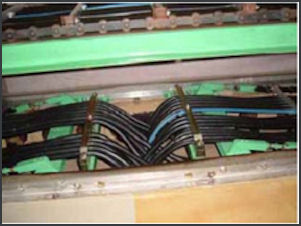
power cables An important milestone was achieved March 20 when a power cable was connected at reactor No. 2 providing electricity to activate the central control room and providing hope that maybe electricity could be restored to cooling system that could stabilize the reactor. Of the four damaged reactors reactor No. 2 suffered the least damage to its pumps and electrical equipment and had the best chance of gets its cooling system up and running. Electricity was sent from the No.2 reactor to the other reactors, an operation that was difficult by debris, radioactive water and high radiation, and getting the cooling system going proved to be an arduous task as back-up water systems motors and power-supply units needed to be repairs or replaced.
About two weeks after the March 11 quake workers were finally able to connect power cables to all six reactors at the plant. Another major milestone was on March 24 when control power was restored. With that objective achieved workers immediately began work on reactivating the pumps and deliver more fresh water to the reactors. By mid-April, an emergency makeshift power supply source was moved to higher ground and a firefighting vehicle was deployed as part of anti-tsunami measures. Backup cooling systems had also been installed.
In early April workers began injecting nitrogen into the reactor containment vessels to deter any new hydrogen explosions. Nitrogen can prevent highly combustible hydrogen from exploding — as it did three times at the compound in the early days of the crisis. Nuclear officials said there was no immediate threat of more explosions, but the nitrogen plans were an indication that such an explosion — within the reactor containment vessel itself not the reactor buildings as was the earlier hydrogen explosions — was a possibility and a sign that many serious challenges still lie ahead.
Cooling the Reactors at Fukushima Power Plant with Water
About 500 tons of water was poured on to the No.1, No. 2 and No. 3 reactors everyday to keep them from overheating. Radiation at reactor No. 1 peaked at 162 sieverts per hour on March 14. Radiation at reactor No. 2 peaked at 138 sieverts per hour on March 15. These readings were recorded after the reactors loss significant amounts of cooling water, leaving large parts of them exposed to the air. The same happened to reactor No. 3 The injection of water caused radiation levels to drop to between 20 and 31 sieverts, 11 to 22 percent of their peaks, by early April.
Initially seawater was used. One of the problems with the salt is that it corrodes water pipes water pipes, increasing the likelihood of leaks. An effort was made to switch over to fresh water as soon as possible. This was largely achieved by late March with the help of a water-carrying barge provided by the U.S. Navy. Some of the operation involved pumping water into the reactor. It also involved spraying water from fire trucks on containment vessel that hold the reactor.
The emergency cooling process of the fuel in the stricken reactors and spent fuel ponds is a process that may continue for a year or more even after fission has stopped. Japanese reactor operators have little choice but to periodically release radioactive steam and water as they accumulate during the cooling process. Until the damaged cooling apparatus was up and running again TEPCO plant's operator must constantly try to flood the reactors with seawater, then release the resulting radioactive steam and water, to keep the reactor cores from melting down, [Source: David E. Sanger and Matt Wald, New York Times, March 14, 2011]
This suggests that the tens of thousands of people who have been evacuated may not be able to return to their homes for a considerable period, and that shifts in the wind could blow radioactive materials toward Japanese cities rather than out to sea. Re-establishing the normal cooling system first required restoring electric power — which was cut in the earthquake and tsunami — and that took weeks and required plant technicians to work in areas that had become highly contaminated with radioactivity. After that more time was needed to make repairs to pumps and other machines necessary to get the cooling system online.
David E. Sanger and Matt Wald wrote in the New York Times: “The essential problem is the definition of ''off'' in a nuclear reactor. When the nuclear chain reaction is stopped and the reactor shuts down, the fuel is still producing about 6 percent as much heat as it did when it was running, caused by continuing radioactivity, the release of subatomic particles and of gamma rays. Usually when a reactor is first shut down, an electric pump pulls heated water from the vessel to a heat exchanger, and cool water from a river or ocean is brought in to draw off that heat.”
“But at the Japanese reactors, after losing electric power, that system could not be used. Instead the operators are dumping seawater into the vessel and letting it cool the fuel by boiling. But as it boils, pressure rises too high to pump in more water, so they have to vent the vessel to the atmosphere, and feed in more water, a procedure known as ''feed and bleed.'' When the fuel was intact, the steam they were releasing had only modest amounts of radioactive material, in a nontroublesome form. With damaged fuel, that steam is getting dirtier.”
Radioactive Water Leaks at the Fukushima Nuclear Plants
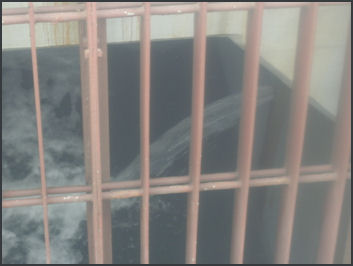
radiation water leak As progress was made keeping fuel rods cool and bringing some degree of control to the crisis, attention shifted to radiation leaks as workers at the Fukushima plant began piling up sandbags and readied emergency storage tanks to stop leaks of highly contaminated water from reaching the ocean.
“On the morning of April 2 when a TEPCO employee who was installing a camera to monitor contaminated water near the No. 2 reactor's water intake saw liquid gushing out from a crack in the side of a concrete shaft into the sea. The worker attempted to measure the radiation level of the water but his dosimeter maxed out. It was over 1,000 millisieverts per hour...It was estimated that 60,000 tons of contaminated water had accumulated in the reactors, an amount that was considered too huge to be dealt with by simply moving it to storage.”[Source: Yomiuri Shimbun, April 2011]
The New York Times reported: “A deluge of contaminated water, plutonium traces in the soil and an increasingly hazardous environment for workers at the plant have forced government officials to confront the reality that the emergency measures they have taken to keep nuclear fuel cool are producing increasingly dangerous side effects. And the prospect of restoring automatic cooling systems anytime soon is fading.”
Readings taken in the sea near the plant in late March showed that levels of radioactive iodine 131 had risen to 4,385 times the statutory limit. The rise seemed to indicate that contaminants from the plant were continuously leaking into the sea.. The day before the water tested at 3,355 times the safety standard for the isotope, up from 1,150 times the maximum level four days before. The same isotope was detected at levels 10,000 the safety limit at Reactor No. 1, according to a TEPCO report. Most of the radioactive water seemed be leaking into the sea from a 20-centimeter crack in a pit used to inspect power cables at No.2 reactor.
On April 7, workers using liquid glass were finally able to stop a leak of highly radioactive water from reactor No.1 into the Pacific. The water entered the sea through a crack near the No.2 reactor’s intake The liquid glass was injected at nine locations near the pit of a tunnel containing radioactive water. The liquid glass was deployed after an attempt too plug the leak with an polymeric absorbent powder used in diapers didn’t work. Before pictures showed a steady stream of water gushing from the crack. After photos showed no leakages.
Discharging Radioactive Water Into the Sea
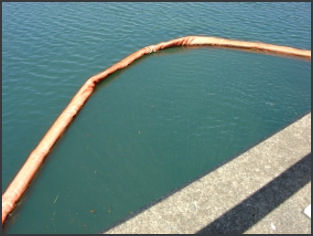
water retaining fence Some of this water leaked out and accumulated in pools under the plant facility. By early April about 80,000 tons of radioactive water had built up in storage facilities and tunnels under the turbine buildings. Some caches of water was more than others. The most radioactive water — containing 2 million times more radioactivity than the low-level radioactive water — was in the basement of the No. 2 reactor
“The government and TEPCO were eventually forced to release water contaminated with low-level radiation into the sea from the plant's waste disposal facilities. On April 4 and 5 — in an action that is believed to have never been taken before on Earth — radioactive water was released from a tank into the sea to make space available to store water contaminated with higher levels of radioactivity.” The previous day, a Democratic Party of Japan lawmaker close to Prime Minister Naoto Kan reportedly told TEPCO officials to "deal with the crises in order of priority." The lawmaker asked the utility to consider releasing the mildly radioactive water into the sea.[Source: Yomiuri Shimbun, April 2011]
About 11,500 tons of low-level radioactive water (the equivalent of about 10 Olympic-size swimming pool) was released into the sea in part to make room for more highly contaminated water. This was done because floating storage facilities and a vessel that decontaminates water that been ordered but would not be delivered until May and drastic action was need to make room for the more highly radioactive water under reactor No. 2 .This caused a big brouhaha — especially among fishermen in the area — as high levels of radioactivity were detected in sea water and some radioactivity was found in caught fish. The head of TEPCO apologized to fishermen as they presented him a formal complaint. Other nations also complained about the releases of radiation into the sea.
The radiation water leaked into the sea from the water leaks was 20,000 times the annual limit. The 520 tons of water that leaked into the sea contained 5,000 terabecquerels, including 4,700 terabecquerels of iodine-131, cesium 134 and cesium 137. This was 30,000 times more than the radioactive substances contained in the 10,000 tons of relatively low-level radioactive water purposely discharged by TEPCO.
A total of 250 tons of highly contaminated radioactive water leaked into the sea in early May from the No. 3 reactor at the Fukushima Daiichi nuclear power plant, TEPCO said. The water, leaked from a pit near a seawater intake of the reactor, contained an estimated 20 terabecquerels of radioactive substances, TEPCO was quoted by Kyodo News as saying. The leak is estimated to have lasted for 41 hours from 2 a.m. on May 10 through 7 p.m. on the following day. The estimated amount of radioactive substances was about 100 times the annual allowable limit for release outside the plant, said TEPCO, but was far less radioactive that the water rleased from Reactor No. 2 in April.
By late April the radioactive material released from Fukushima nuclear power plant was one percent of what it was and the concentrations of iodine-131 in seawater near the plant were below government-set danger limits.
Researchers at the Meteorological Research Institute and the Central Research Institute of Electric Power Industry estimated that the amount of radioactive cesium-137 that was directly released into the sea came to 3,500 terabecquerels from March to the end of May, while estimating that roughly 10,000 terabecquerels fell into the ocean after it was released into the air.
In October 2011, the French government's nuclear research institute, IRSN, said the amount of radioactive cesium that has leaked from Fukushima Daiichi nuclear power plant into the ocean is 20 times larger than TEPCO estimated. Their report calculated that 27.1 thousand terabecquerels of radioactive cesium 137 had leaked into the ocean as of the middle of July. The largest amount was released by early April from a pit at the Number 2 reactor and other plant facilities, about 20 times the estimate made by TEPCO. The report says the nuclear accident caused significant water contamination, but radioactive substances will be dispersed by ocean currents. [Source: japan-afterthebigearthquake.blogspot.com October 30, 2011]
In October 2011, NHK reported, high concentrations of radioactive cesium have been found in plankton from the sea near the Fukushima Daiichi Nuclear Power Plant. Researchers from Tokyo University of Marine Science and Technology collected plankton in waters up to 60 kilometers from the coast of Iwaki City in July. They found 669 becquerels per kilogram of radioactive cesium in animal plankton from waters 3 kilometers offshore. They say a wide range of fish feed on animal plankton and that the contamination could accumulate in the food chain and have a more serious impact when its gets into relatively large fish. The research group's leader, Professor Takashi Ishimaru, says the plankton were so heavily contaminated because sea currents continuously carried contaminated water southward from the nuclear plant. He says detailed studies are needed to determine how long the effect on fish will continue. [Source: japan-afterthebigearthquake.blogspot.com, NHK, October 15, 2011]
Storing Radioactive Water
Getting rid of the water in the tunnels under the turbine is a critical step in getting the reactor cooling system operating again so the reactors can be stabilized. Releasing highly radioactive water into the sea is not an option, A megafloat capable of holding 10,000 tons and 400 makeshift storage tanks capable of holding 20,000 tons are supposed to arrive at the plant in mid April. In the meantime TEPCO was studying the possibility of distilling the radioactive water to reduce its volume so less storage space would be needed.
In mid April work began on removing highly radioactive water — particularly in the basements of reactors No. 1 and No.3 reactors and the trenches that connect them “which had prevented restarting the reactor’s cooling system and stabilizing the plant. The goal was to transfer 60,000 tons of water to nearby tanks and other storage facilities. The workers began by pumping water near the No.2 reactor which was rising apparently because of action to stop leaks of radioactive water into the sea.
Workers Battle Radiation Leaks at the Fukushima Nuclear Plants
David Jolly and Matthew L. Wald wrote in the New York Times, “Workers have been dousing reactors and spent-fuel pools at the plant with water to prevent full meltdowns while they frantically try to restore power and restart the cooling systems, but the resulting floods of dangerously contaminated water have complicated their efforts. On Thursday workers prepared more tanks for transferring the water from turbine buildings at Reactors 1, 2 and 3 in a quest to keep the radioactive water from flooding into the ocean.[David Jolly and Matthew L. Wald, New York Times, March 31, 2011]

megafloat storage vessel
One of the most dangerous jobs was pumping contaminated water from the pools in the turbine buildings. NHK reported that because many of the plant’s radiation detectors were destroyed in the earthquake workers have had to share the devices in small groups. Under normal circumstances each worker would have a device since it is not possible to accurately measure individual radiation exposure without them. Some workers have become enraged and walked off the job as a result, NHK reported. Enough devices eventually arrived, the Daily News reported, so there was now enough for everyone. But safety standards have repeatedly been relaxed to ensure work can continue without violations.
TEPCO said 18 employees and three contractors were exposed to 100 millisieverts of radiation. The average dose for a nuclear plant worker is 50 millisieverts over five years. Two workers in Reactor 3 were admitted to hospital after their feet were exposed to 170-180 millisiverts — levels close to what emergency workers are allowed to be exposed to in a year — according to the International Atomic Energy Agency. The radiation radioactivity was in water that seeped in through the top of their boots. The workers were trying to reconnect a power cable under reactor No. 3; they continued with their work even though their radiation dosimeters warned them of high levels of nuclear reactor in the area. In the early days of the crisis one workers
During the crisis at the Fukushima plant the Japanese government raised the legal limit of radiation workers could be exposed to from 100 to 250 millisieverts,” Chris Hogg of the BBC wrote. “That is more than 12 times the legal dose for workers dealing with radiation under British law. But you would need to be exposed to a dose probably twice that maximum before you would expect to see the so-called “early effects” people associated with radiation sickness, like a lowering of white blood cells. You would need a level of exposure in the region of 1,000 millisieverts before you might feel nauseous or feel ill. The "late effects" of exposure to radiation may not occur for many years. It can increase the likelihood you will develop cancer, but this is only an increased possibility, not a certainty.” [Source: Chris Hogg BBC News, March 17, 2011]
In mid April, workers began installing enclosures in the sea just outside the Fukushima nuclear power plant to prevent radioactive water from spreading into the Pacific. Around the same time TEPCO began using a small unmanned helicopter — the Honeywell-produced T-hawk — to survey the plant and get a look inside the No. 1 to No. 4 reactor — something workers had been unable to do because of worries about radiation. Designed for military use, the 7.7-kilogram T-Hawk has two video cameras and can be operated from than 10 kilometers away. GPS technology allows it a hoover at precise locations.
Water Decontamination at Fukushima
There are three main contaminated water issues at Fukushima: 1) the amount of radioactive water increases by 400 tons at the plant every day. Nuclear fuel in the plant's Nos. 1, 2 and 3 reactors, all damaged by the March 11, 2011, disaster, continues to generate heat and needs to be cooled with water. But the cooling water keeps escaping from the damaged reactors. Moreover, groundwater flowing down from the hills has seeped into the reactor buildings, increasing the amount of tainted water to 430,000 tons. 2) Contaminated water has leaked from makeshift storage tanks. Because of weak joints in the 1,000-ton steel tanks, an estimated 300 tons of water has leaked from a faulty tank. 3) Third, highly radioactive water that accumulated in underground tunnels that hold pipes and cables, which are connected to the reactor and turbine buildings, has found its way into the plant's harbor. TEPCO has said it has seen a rise in radiation levels due to the water leaks at a well near a protective wall and a location within the harbor sur-rounded by jetties and an "undersea curtain." Radiation readings at the harbor entrance, about 500 meters offshore, are reportedly about one-500th of the maximum level set by World Health Organization guidelines for drinking-water quality. [Source: mapjp.blogspot September 12, 2013]
After the March 11 earthquake and tsunami water was poured on the reactors at Fukushima nuclear power plant to cool them. Immediately after the crisis began, water contaminated with radioactive substances used to cool the reactors built up inside their facilities. A decontamination system was set up to filter and recycle this water.
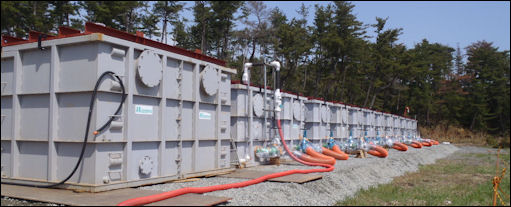
water purification
In July 2011, the Yomiuri Shimbun reported: “Decontamination of highly radioactive water at the Fukushima No. 1 nuclear power plant has been proceeding at a snail's pace because of various malfunctions and other problems” with “the average operating rate of the decontamination system only 63 percent.” In a month about 29,000 tons of radioactive water have been decontaminated with the plan to reduce the contaminated water to a safe level by early August behind schedule. The new goal was late September.
The system, which was built in less than two months, has frequently broken down due to faulty valve operations and a malfunctioning alarm system. At one point it stopped working for eight hours due to a power outage. TEPCO's target operation rate was 90 percent. By August the decontamination system began working steadily to filter and recycle this water.
Leaks in the Containment Vessel at Reactor No. 1
In May it was revealed that Reactor No. had sustained much more damage than originally thought and was leaking water — a development that is likely to delay efforts to bring the Fukushima Daiichi Nuclear Power Station under control. The TEPCO to bring the plant into a relatively stable state in six to nine months has been predicated on the notion that it could efficiently cool the fuel in several reactors — a harder task if water is leaking out. The company had long suspected that the containment vessels at two other reactors were breached and leaking, but it had hoped the No. 1 reactor was intact and therefore easiest to bring under control. [Source: Hiroko Tabuchi and Matthew L. Wald, New York Times, May 12, 201]
The nuclear fuel that fell to the bottom of the No. 1 reactor pressure vessel is being cooled by the continued injection of water from outside the reactor. At least for the time being, there is little likelihood that a large amount of radioactive material will be released into the environment. However it was found in May that the pressure vessel had been damaged and that water poured in to cool the fuel was leaking from the vessel. [Source: Yomiuri Shimbun, May 18 2011]
The utility had planned to bring the No. 1 reactor to a cold shutdown by starting a system as early as May to recirculate water leaked from the containment vessel after cooling it. Of the three crippled reactors, the No. 1 reactor was believed to be somewhat under control with technicians able to safely enter the building to begin work to restore the cooling system. But TEPCO found more than 3,000 tons of water in the basement of the reactor building on May 13, an accumulation far larger than anticipated.[Source: Hidenori Tsuboya, Asahi Shimbun, May 18, 2011]

dust collector system
Setback Caused by the Leaks in the Containment Vessels
According to a timetable set in April by the government and TEPCO to bring the nuclear accident under control, the No. 1 reactor would be cooled by filling the containment vessel with water to a level covering the 4-meter-long fuel rods inside the pressure vessel, and create a system that would enable the coolant water to circulate around the reactor to stably keep the fuel.
But TEPCO effectively gave up the plan to flood the container with water in its updated road map, after recent findings suggested that a large part of the fuel had melted and that the container appears to be leaking massive amounts of water injected into the reactor as an emergency post-disaster measure to keep the fuel cool. Should the leak continue for several months, highly radioactive water could escape from the building. If rainwater enters the building through the damaged section during the upcoming rainy season, the amount of contaminated water will increase further. One idea proposed by the government is consider ways to decontaminate water used to cool fuel in the reactor so that the water can be reused.
The meltdown of fuel rods at the No. 2 and No. 3 reactors seems highly likely. It is also probable that radioactive water is escaping the reactor buildings through holes in the pressure vessels and in the outer containment vessels as well. Workers have been unable to enter reactors No. 2 and No. 3 because of high levels of radiation. [Source: Hidenori Tsuboya, Asahi Shimbun, May 18, 2011]
Repair work is going slowly. TEPCO is trying to prevent a recurrence by transferring the contaminated water to a disposal and treatment facility. Data acquired by a robot sent into the No. 2 reactor building indicated that it will be impossible for engineers to work inside the building any time soon because of high levels of humidity and radioactivity. Like the No. 2 reactor, robot data indicated that it is unsafe for humans to work in the No. 3 reactor building, with radiation levels in some areas above 100 millisieverts per hour. Debris after a hydrogen explosion on March 14 remains scattered inside the building and is another obstacle to repair work.
To add to growing concerns, the No. 3 reactor remains volatile, with temperatures inside the pressure vessel increasing since late April after dropping earlier. TEPCO began pumping water from a new site into the reactor May 12, but engineers are concerned that sufficient water is not remaining in the pressure vessel because of the broken piping. Also, the utility has been unable to start pumping nitrogen gas into the containment vessel to deter another hydrogen explosion. It began injecting water mixed with boric acid to contain the nuclear reaction May 15.
Circulation of Clean Water
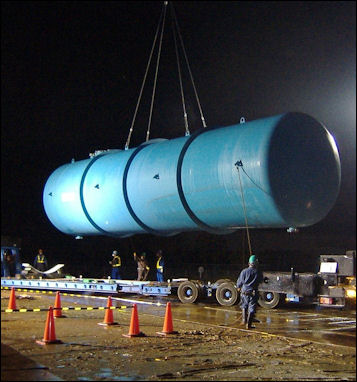
storage tanks The most urgent problem facing workers at Fukushima Daiichi is how to deal with vast quantities of highly radioactive water that has accumulated in the basements and ditches of the reactor buildings, turbine buildings, and nearby areas. The estimated 110,000 tons of contaminated liquid — including coolant liquid leaking from damaged reactors and runoff from water used to douse overheating reactors — is hampering efforts to repair the plant's cooling systems. There are fears the water may overflow into the Pacific Ocean.”
In late June, according to Kyodo, TEPCO said started cooling the crippled nuclear reactors at the Fukushima Daiichi power complex by using decontaminated water produced from a newly installed water treatment system. The start of "circulating injection cooling" is seen as a key step to achieve both the stable cooling of the Nos. 1 to 3 reactors and the reduction of highly radioactive water that is accumulating inside the plant's premises as a result of an emergency measure to keep injecting water into the reactors from outside. [Source: Kyodo, June 27 2011]
"We've taken a large step" in efforts to restore the crisis-hit plant, Goshi Hosono, a special adviser to Prime Minister Naoto Kan on handling the nuclear disaster, said at a press conference announcing the start of the water circulation in the afternoon. The system include 370 tractor-trailer-size storage tanks capable of holding between 100 tons and 120 tons of water. The 136-meter-long, 36-meter-wide megafloat — capable of storing about 10,000 tons of water — arrived at Fukushima nuclear power plant in late May. It was originally used in the city of Shizuoka as a park for sea fishing.
TEPCO also set up a water treatment system designed to remove radioactive substances from the highly contaminated water, although it has been plagued by water leakage and other trouble with the system.
Hidehiko Nishiyama, a spokesman for the government's Nuclear and Industrial Safety Agency, said at a press conference earlier Monday the main focus of the circulating injection cooling at the beginning would be on reducing the amount of polluted water to lessen the risks of overflowing.
In early June the cooling system for the water in a temporary storage pool for spent nuclear fuel rods in the No. 2 reactor at Fukushima was fully restored. It was the first such achievement since the March 11 disaster and months ahead of schedule. This represented the first full, stable recovery of a cooling system at the plant since it suffered extensive damage in the March 11 disaster. The system cools a pipe that run from the temporary storage pool into a heat exchanger, using the cooling water in the exchanger. The water from the heat exchanger is cooled with air from a fan. The temperature of the water in the storage pool is currently 70 C to 80 C. As water in the pool is lost through vaporization, additional water is poured into the pool to compensate. [Source: June 2, 2011]
If the cooling system works efficiently, the temperature will be stabilized at around 40 C, according to TEPCO. The humidity in the No. 2 reactor building has been as high as 99 percent, due to steam from the fuel pool and other factors. If the humidity goes down, much more efficient work will be possible in the building. A similar system will be put into operation for the Nos. 1 and 3 reactor buildings by the end of this month and at the No. 4 reactor building in July, according to TEPCO.
Water Falling like Rain Inside Fukushima Reactor
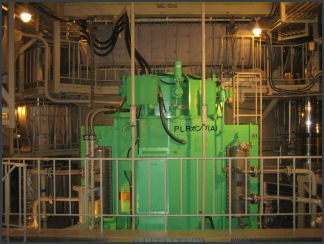
recirculation pump In January 2012, TEPCO released 30 minutes of video footage inside the containment vessel of the Fukushima No. 1 nuclear power plant's No. 2 reactor, the first such images released. The Yomiuri Shimbun reported: Drops of water fall like rain in the video, which was shot using an industrial endoscope. The drops were apparently the result of vapor--created by the heat from melted nuclear fuel--that cooled inside the upper part of the reactor containment vessel. [Source: Yomiuri Shimbun, January 21, 2012]
Strong radiation caused scattered white static in the footage, which displayed the severe environment inside the containment vessel, observers said. The vessel's pipes did not appear to be significantly damaged, but paint had fallen off the inner wall, due possibly to high temperatures following the outbreak of the nuclear crisis.
The endoscope was inserted about two meters into the containment vessel through a hole about seven meters above the bottom of the containment vessel. Visibility was about two meters to three meters. Melted nuclear fuel is believed to have fallen to the concrete bottom of the containment vessel, but this could not be confirmed.
Also, the water level inside the reactor was found to be lower than initially estimated. Although TEPCO believed water had collected to a height of 4.5 meters, the examination showed the water height was apparently less than four meters, as the surface of the water was not seen around the iron scaffolding set at a height of four meters. As one reason why there was less water than TEPCO estimated, the company said the gauge that measures the location of the water's surface did not work accurately.However, the gauge placed 2.8 meters from the bottom of the vessel indicated a possibility there is water at that level, TEPCO sources said. "It's quite unlikely nuclear fuel was exposed, as liquid from condensation is dripping down," a TEPCO official said.
Contaminated Water at Fukushima Rises to Crisis Level in 2013
In April 2013, Martin Fackler wrote in the New York Times: “Two years after a triple meltdown the Fukushima Daiichi nuclear power plant is faced with a new crisis: a flood of highly radioactive wastewater that workers are struggling to contain. Groundwater is pouring into the plant’s ravaged reactor buildings at a rate of almost 75 gallons a minute. It becomes highly contaminated there, before being pumped out to keep from swamping a critical cooling system. A small army of workers has struggled to contain the continuous flow of radioactive wastewater, relying on hulking gray and silver storage tanks sprawling over 42 acres of parking lots and lawns. The tanks hold the equivalent of 112 Olympic-size pools. [Source: Martin Fackler, New York Times, April 29, 2013 /*/]
“But even they are not enough to handle the tons of strontium-laced water at the plant — a reflection of the scale of the 2011 disaster and, in critics’ view, ad hoc decision making by the company that runs the plant and the regulators who oversee it. In a sign of the sheer size of the problem, the operator of the plant, Tokyo Electric Power Company, or TEPCO, plans to chop down a small forest on its southern edge to make room for hundreds more tanks, a task that became more urgent when underground pits built to handle the overflow sprang leaks in recent weeks. “The water keeps increasing every minute, no matter whether we eat, sleep or work,” said Masayuki Ono, a general manager with TEPCO who acts as a company spokesman. “It feels like we are constantly being chased, but we are doing our best to stay a step in front.” /*/
“While the company has managed to stay ahead, the constant threat of running out of storage space has turned into what TEPCO itself called an emergency, with the sheer volume of water raising fears of future leaks at the seaside plant that could reach the Pacific Ocean. That quandary along with an embarrassing string of mishaps — including a 29-hour power failure affecting another, less vital cooling system — have underscored an alarming reality: two years after the meltdowns, the plant remains vulnerable to the same sort of large earthquake and tsunami that set the original calamity in motion. /*/
“The situation is worrisome enough that Shunichi Tanaka, a longtime nuclear power proponent who is the chairman of the newly created watchdog Nuclear Regulation Authority, told reporters after the announcement of the leaking pits that “there is concern that we cannot prevent another accident.” A growing number of government officials and advisers now say that by entrusting the cleanup to the company that ran the plant before the meltdowns, Japanese leaders paved the way for a return to the insider-dominated status quo that prevailed before the disaster. /*/
“Even many scientists who acknowledge the complexity of cleaning up the worst nuclear disaster since Chernobyl fear that the water crisis is just the latest sign that TEPCO is lurching from one problem to the next without a coherent strategy. “TEPCO is clearly just hanging on day by day, with no time to think about tomorrow, much less next year,” said Tadashi Inoue, an expert in nuclear power who served on a committee that drew up the road map for cleaning up the plant. /*/
“Concerns extend well beyond TEPCO. While doing a more rigorous job of policing Japan’s nuclear industry than regulators before the accident, the Nuclear Regulation Authority has a team of just nine inspectors to oversee the more than 3,000 workers at Fukushima. And a separate committee created by the government to oversee the cleanup is loaded with industry insiders, including from the Ministry of Trade, in charge of promoting nuclear energy, and nuclear reactor manufacturers like Toshiba and Hitachi. The story of how the Fukushima plant ended up swamped with water, critics say, is a cautionary tale about the continued dangers of leaving decisions about nuclear safety to industry insiders. /*/
Dealing with the Contaminated Water at Fukushima
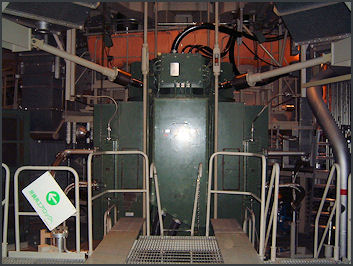
recirculation pump Martin Fackler wrote in the New York Times: “The jury-rigged cooling loop that pours water over the damaged reactor cores is a mazelike collection of pumps, filters and pipes that snake two and a half miles along the ground through the plant. And a pool for storing used nuclear fuel remains perched on the fifth floor of a damaged reactor building as TEPCO struggles to move the rods to a safer location. [Source: Martin Fackler, New York Times, April 29, 2013 /*/]
“When TEPCO and the government devised the current plans for decommissioning the plant in late 2011, groundwater had already been identified as a problem — the plant lies in the path of water flowing from nearby mountains to the sea. But decision makers placed too low a priority on the problem, critics say, assuming the water could be stored until it could be cleaned and disposed of. /*/
“According to some who helped the government plan the cleanup, outside experts might have predicted the water problem, but TEPCO and the government swatted away entreaties to bring in such experts or companies with more cleanup expertise, preferring to keep control of the plant within the collusive nuclear industry. TEPCO also rejected a proposal to build a concrete wall running more than 60 feet into the ground to block water from reaching the reactors and turbine buildings, and the Trade Ministry did not force the issue, according to experts and regulators who helped draw up the decommissioning plan. /*/
“Instead, TEPCO made interim adjustments, including hastily building the plastic- and clay-lined underground water storage pits that eventually developed leaks. It was only after the discovery of those leaks that the regulation agency was added as a full-fledged member to the government’s cleanup oversight committee. “We were so focused on the fuel rods and melted reactor cores that we underestimated the water problem,” said Tatsujiro Suzuki, vice chairman of the Japan Atomic Energy Commission, a government body that helped draw up TEPCO’s original cleanup plan. “Someone from outside the industry might have foreseen the water problem.” /*/
“TEPCO rejects the criticism that it has mishandled the growing groundwater problem, saying that the only way to safely stop the inflow is by plugging the cracks in the damaged reactor buildings. It contends that no company in the world has the ability to do that because it would require entering the highly radioactive buildings and working in dangerously toxic water several feet deep. “We operate the plant, so we know it better than anyone else,” said Mr. Ono, the TEPCO spokesman. He then teared up, adding, “Fixing this mess that we made is the only way we can regain the faith of society.” /*/
Plans to Dump Contaminated Water Into the Sea
Martin Fackler wrote in the New York Times: “But the biggest problem, critics say, was that TEPCO and other members of the oversight committee appeared to assume all along that they would eventually be able to dump the contaminated water into the ocean once a powerful new filtering system was put in place that could remove 62 types of radioactive particles, including strontium. [Source: Martin Fackler, New York Times, April 29, 2013 /*/]
“The dumping plans have now been thwarted by what some experts say was a predictable problem: a public outcry over tritium, a relatively weak radioactive isotope that cannot be removed from the water. Tritium, which can be harmful only if ingested, is regularly released into the environment by normally functioning nuclear plants, but even TEPCO acknowledges that the water at Fukushima contains about 100 times the amount of tritium released in an average year by a healthy plant. /*/
The public outcry over the plans to dump tritium-tainted water into the sea — driven in part by the company’s failure to inform the public in 2011 when it dumped radioactive water into the Pacific — was so loud that Prime Minister Shinzo Abe personally intervened last month to say that there would be “no unsafe release.” Meanwhile, the amount of water stored at the plant just keeps growing. “How could TEPCO not realize that it had to get public approval before dumping this into the sea?” said Muneo Morokuzu, an expert on public policy at the University of Tokyo who has called for creating a specialized new company just to run the cleanup. “This all just goes to show that TEPCO is in way over its head.” /*/
Radioactive Water Leaks at Fukushima as Operator Underestimates Rainfall
In October 2013, Antoni Slodkowski of Reuters wrote: “Highly radioactive water overflowed barriers into Japan's Fukushima Daiichi nuclear power plant, TEPCO said, after it underestimated how much rain would fall at the plant and failed to pump it out quickly enough. Dealing with hundreds of tonnes of groundwater flowing through the wrecked nuclear plant daily is a constant headache for the utility and for the government, casting doubt on Prime Minister Shinzo Abe's promises that the Fukushima water "situation is under control." [Source: Antoni Slodkowski, Reuters, October 20, 2013]
“After heavy rain, water with high levels of radioactive strontium overflowed containment areas built around some 1,000 tanks storing tonnes of radioactive water at the plant, TEPCO said. The radioactive water is a by-product of an improvised cooling system designed to keep the wrecked reactors under control in case of further disaster. TEPCO said it had planned to pump out the accumulating rainwater into empty tanks, check it for radioactivity, and if it was uncontaminated, release into the sea. But the company was overwhelmed by the amount of rainwater.
"Our pumps could not keep up with the rainwater. As a result, it flowed over some containment areas," said TEPCO spokesman Yoshikazu Nagai. The company had planned for 30 to 40 millimeters of rainfall, but by late afternoon the rainfall already stood at around 100 millimeters, he said. Earlier in year, TEPCO lost power to cool spent uranium fuel rods at the plant after a rat shorted wiring at the plant. In the latest incident, containment areas surrounding 12 of 23 groups of tanks overflowed, with one of them containing Strontium-90 as highly concentrated as 710 Becquerels per liter - 71 times higher than the level set by the company as safe for release. Strontium-90 is a by-product of the fission of uranium and plutonium in nuclear reactors as well as nuclear weapons, the U.S. Environmental Protection Agency says on its website.
“TEPCO said it will prepare some 30 extra pumps and lay additional 10 kilometers of pipes to prevent overflowing from happening again. The utility has come under increased scrutiny after it found in August that 300 tonnes of highly radioactive water had leaked from one of the hastily built storage tanks at the Fukushima site. Japan stepped up support for the embattled utility in September, pledging half a billion dollars to help contain contaminated water at Fukushima.
Soil Around Fukushima to Be Frozen to Stop Groundwater Leaking in
Mark Willacy of ABC wrote: “The Japanese government has ordered the operator of the Fukushima nuclear plant to freeze the soil around its crippled reactor buildings to stop groundwater seeping in and becoming contaminated.Every day another 400 tonnes of groundwater forces its way into the plant, becomes contaminated with radioactivity and needs to be stored onsite. Plant operator Tokyo Electric Power Company (TEPCO) already has a quarter of a million tonnes of radioactive water stored in tanks at Fukushima. [Source: Mark Willacy, ABC, May 31, 2013 +=+]
“Fearing the nuclear plant is running out of space to store contaminated water, the Japanese government has ordered TEPCO to take the drastic step. The government hopes these frozen walls of soil will stop huge amounts of groundwater leaking into the buildings and it wants the system to be in place within two years. According to a report compiled by a government panel, there are no previous examples of using walls created from frozen soil to isolate groundwater being used for longer than a few years. +=+
Fukushima Reactor Water Level Shallower than Thought
In March 2012, the Yomiuri Shimbun reportedl: The water level in the containment vessel of the No. 2 reactor at the Fukushima No. 1 nuclear power plant is only about 60 centimeters deep, far shallower than previously assumed levels of about four meters, according to Tokyo Electric Power Co. The lower-than-expected water level was discovered for the first time when the power utility used an industrial endoscope to check the crippled reactor's interior on Monday, TEPCO said. [Source: Yomiuri Shimbun, March 28, 2012]
According to some experts, it is possible that nuclear fuel that melted through the reactor's pressure vessel and accumulated on the bottom of the containment vessel in the aftermath of the March 11 earthquake and tsunami may not be completely covered in the water. TEPCO said the water temperature in the vessel remained relatively low within a range of 48.5 C to 50 C. The discovery of the unexpectedly shallow water level will not affect TEPCO's judgment that the reactor is in a state of "cold shutdown."
Image Sources: Tepco and YouTube
Text Sources: New York Times, Washington Post, Los Angeles Times, Times of London, Yomiuri Shimbun, Daily Yomiuri, Japan Times, Mainichi Shimbun, The Guardian, National Geographic, The New Yorker, Time, Newsweek, Reuters, AP, Lonely Planet Guides, Compton’s Encyclopedia and various books and other publications.
Last updated January 2014
